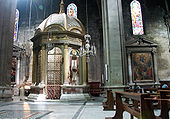- Matteo Civitali
-
Matteo Civitali (1436–1502) was an Italian sculptor and architect, painter[1] and engineer from Lucca. He was a leading artistic personality of the Early Renaissance in Lucca, where he was born and where most of his work remains. He was trained in Florence, where Antonio Rossellino and Mino da Fiesole influenced his mature style. He is known to have sculpted statues of Adam, Eve, Abraham, Saints Zacchariah and Elizabeth, and others for the chapel of San Giovanni Battista in Genoa Cathedral.[2] He is mentioned with the name of Matteo Civitali by Vasari in his biography of Jacopo della Quercia, and appears to have taken up the art of sculpture at the age of 40 years, after years of practicing as a "barber" (surgeon).[2]
His free-standing chapel, the "tempietto", built in 1484 to enshrine the Holy Face of Lucca, stands in the left nave of the Cathedral of San Martino, Lucca. The Duomo contains also a virtual anthology of Matteo's sculpture, since he worked at the San Romano Altar, and also sculpted the S.Sebastian in the back of the Holy Face Shrine, and two monumental graves in the right transept.
Matteo Civitali died October 12, 1501. The relief of Faith (now in the National Museum of Florence, Italy) was originally the first segment part of Hope and Love, a triple relief.This marble figure of Faith was acquired by the Uffizi Gallery in 1830 from the prior of a church at Paterno near Florence. This piece of work existed in the church of Saint Michele in Lucca.
Notes
References
- "Matteo Civitali and his time" Exhibition, Villa Guinigi, Lucca, 2004.
- Harms, Martina, Matteo Civitali, Bildhauer der Fruhrenaissance in Lucca (Beitrage zur Kunstgeschichte des Mittelalters und der Renaissance, 1) Münster: Rhema-Verlag, 1995. ISBN 978-3-930454-00-6. Comprehensive monograph.
- Soprani, Raffaello (1769). Carlo Giuseppe Ratti. ed. Delle vite de' pittori, scultori, ed architetti genovesi; Tomo secundo scritto da Carlo Giuseppe Ratti. Stamperia Casamara in Genoa, dalle Cinque Lampadi, con licenza de Superiori; Digitized by Googlebooks from Oxford University copy on Feb 2, 2007. pp. pages 373–374. http://books.google.com/books?id=vFcGAAAAQAAJ&dq=Genovesi+Raffaello+Soprani.
Categories:- 1436 births
- 1502 deaths
- People from Lucca
- Italian architects
- Italian sculptors
- Renaissance sculptors
- Italian architect stubs
- Italian sculptor stubs
Wikimedia Foundation. 2010.


